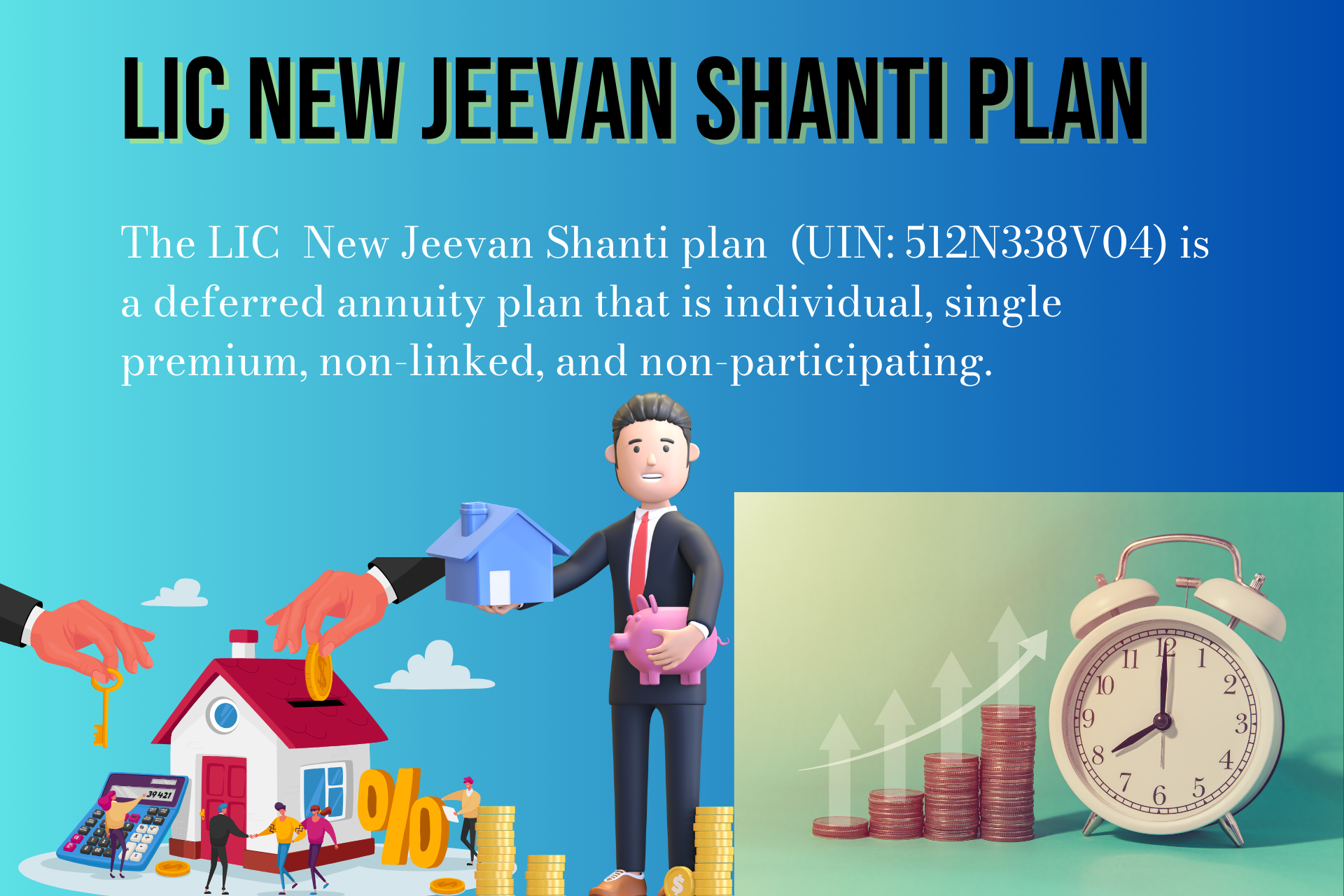The LIC New Jeevan Shanti plan (UIN: 512N338V04) is a deferred annuity plan that is individual, single premium, non-linked, and non-participating.
This is a single premium plan that gives the policyholder the choice of a deferred annuity for either a single life or a joint life.
• Annuities are paid after the deferment period for the duration of the annuitant(s)’ life, with guaranteed annuity rates from the policy’s start.
• Both online and offline purchases are accepted for this plan.
2. Annuity Options:
There are the following options:
Option 1: Single life deferred annuity
Option 2: Joint life deferred annuity
Once chosen the annuity option cannot be changed.
Advantages of Option 1
During the Deferment Period:
• Nothing will be paid if the annuitant survives. • The nominee(s) will receive the Death Benefit, as described below, upon the annuitant’s death.
Following the Deferment Period:
• When the annuitant passes away, the annuity payments will stop immediately, and the nominee(s) will receive the Death Benefit as outlined below. • The annuity payments will be made in arrears according to the chosen method for the duration of the annuitant’s life.
During the Deferment Period, Option 2:
• Nothing will be due if the Primary Annuitant and/or Secondary Annuitant survive.
• The nominee(s) will receive the Death Benefit, as specified below, upon the passing of the last survivor.
Following the Deferment Period:
• The annuity payments will cease immediately upon the death of the last survivor, and the nominee(s) will receive the Death Benefit as specified below. • The annuity payments, according to the selected mode, will be provided in arrears for as long as the Primary Annuitant and/or Secondary Annuitant is alive.

3. LIC new jeevan shanti plan Death Benefit:
Under both options, the death benefit will be the greater of the following: the purchase price + any accumulated additional benefit at death (as detailed below) less the total annuity amounts due until the date of death, if any
OR
• A purchase price of 105%
Gained Extra Benefit upon Death:
Up until the end of the Deferment Period alone, Additional Benefit on Death will accumulate at the conclusion of each policy month. The following will be the rate of Additional Benefit upon Death for the Deferment Period:
Monthly Additional Benefit upon Death = Purchase Price * Annual Annuity Rate (paid on a monthly basis) / 12
Whereas the Annuity Rate p.a. payable on a monthly basis will be determined by the Option selected, the Age of the Annuit(s) at Entry, and the Deferment Period selected, and will equal the Annuity Cost per unit Acquire Price that applies to the monthly mode without any bonuses.
If the policy is surrendered or the annuitant dies during the deferral period, the Additional Benefit on Death for the policy year in which the death or surrender happened will begin to accumulate on the date of the death or surrender and will continue until the completed policy month.
4. LIC new jeevan shanti plan Qualification Standards:
Minimum Purchase Price :
Rs-1,50,000, subject to the following minimum Annuity
Maximum Amount Paid: Indefinite
In order to satisfy the minimum annuity condition as stated below, the aforementioned minimum purchase price would be raised suitably.
30 years old is the minimum entry age (last birthday).
Entry-level Maximum Age: 79 Years (Last Birthday)
31 years old is the minimum vesting age (last birthday).
80 years old is the maximum vesting age (last birthday).
One year is the minimum deferment period.
Twelve years is the maximum deferment period, subject to the maximum vesting age.
Joint Life:
Any two lineal descendants or descendants of a family (grandparents, parents, children, or grandchildren), as well as a spouse or sibling, may take up a joint life annuity.
Exceptional situations in which the minimum purchase price of less than Rs-150,000 and the minimum annuity do not apply:
The plan may be purchased without any restrictions on the minimum annuity if it is for the benefit of a dependent person with a disability (Divyangjan). In such circumstances, the minimum purchase price is Rs-50,000/-.

5. Annuity payment mode:
There are four different annuity payment options: annually, half-yearly, quarterly, and monthly. The Annuity will be paid out in arrears, meaning that the annuity payment will be made after one year, six months, three months, or one month from the Annuity’s vesting date, depending on whether the Annuity payment pattern is quarterly, monthly, half-yearly, or annual.
6. LIC new jeevan shanti plan Incentive:
This strategy offers the following incentives:
i. Reward for a greater purchasing price:
An incentive to increase the purchasing price through an annuity rise three purchasing price slabs are offered at this rate: i) Rs 5,00,000 to Rs 9,99,999 ii) from Rs 10,000,001 to Rs 24,99,999 iii) from Rs 25,00,000 and beyond.
The purchase price slab and the deferment duration determine the incentive for a higher purchase price. The incentive rises in tandem with the purchase price as it moves from the lower to the higher slab and the lengthening of the deferment time.
ii. The following is the incentive for direct sales, which is an increase in the annuity rate:
For insurance acquired online and as QROPS, a 2% rebate will be applied in the form of an increase in the annuity rate.
7. Annuity rate reduction:
If annuity payments are made at intervals other than annually, the annuity rate will be reduced accordingly. The following is the reduction:
Moderate The percentage Diminished annual annuity rate
2% every six months
Every three months 3%
Every month, 4%
8. Example
Purchase price: 10 lakhs, not including any relevant taxes.
Annuitant’s age upon admission: 45 years old (last birthday)
12-year deferment period
Secondary Annuitant’s age upon admission: 35 years old (last birthday)
(relevant only to Option 2)
Option for Annuities
Annuity Amount Payable for every available mode of annuity payment
Half a year annually every three months Every month
Option 1: Single life deferred annuity
1,39,900; 68,551; 33,926; 11,192
Option 2: Joint life with deferred annuity
1,32,200; 64,778; 32,059; 10,576

9. Choices:
i) Death Benefit Payment choices:
In order to pay the nominee(s) for the death benefit, the annuitant(s) must select one of the following choices. The death claim amount will then be paid to the nominee(s) in accordance with the Annuitant(s)’ exercised option, and the nominee(s) will not be permitted to make any changes. Annuitant(s) must utilize this option during the proposal phase. Nonetheless, the annuitant(s) may change this decision at any time while the policy is still in effect.
• Lumpsum Death Benefit:
If this option is selected, the nominee(s) will get the full death benefit in lump sum.
• Annuization of Death Benefit:
In this scenario, the death benefit sum is allocated for acquiring an Instant Annuity from the Company for nominee(s), with effect from the nominee’s passing date last survivor or annuitant. The amount of annuity due to on the admission of death claim, the candidate or nominees shall be depending on the immediate annuity and nominee(s)’ ages rates in effect as of the annuitant’s death date (last victim in the event of a joint life annuity). This choice can be chosen to receive all or a portion of the benefit amount due. upon passing away.
The annuity payments for each nominee, however, will be contingent upon meeting the eligibility requirements of the annuity plan that is offered at that particular time as well as the then-current regulatory regulations regarding the minimum limits for annuities.
The aforementioned amount will be paid as a lump payment to the nominee(s) in the event that the eligibility requirements of the annuity plan that was available at the time are not satisfied or the benefit amount due upon death is insufficient to purchase the minimum amount of annuity.
Installment:
This option allows the benefit amount payable upon death to be paid out over a selected 5-year period in payments rather than as a single sum.
This option may be used to claim all or a portion of the policy’s death benefit. The sum chosen by the Annuitant(s) (i.e., net claim amount) may be expressed as a percentage of the entire amount of claim profits payable or as an absolute sum.
The installments must be paid in advance at quarterly, monthly, half-yearly, or annual intervals, depending on the method of payment selected. The minimum installment amount for each mode of payment is as follows:
Method of Payment for Installments Monthly Rs-5,000/-, quarterly Rs-15,000/-, half-yearly Rs-25,000/-, and annually Rs-50,000/- is the minimum installment amount.
The claim process will only be paid in lump sum if the net Claim Amount is less than what is needed to give the minimum installment amount in accordance with the Annuitant(s)’ chosen option.
The interest rate that applies to determine the installment amount for all installment payment options that start on May 1 and run through April 30 will be the annual effective rate, which cannot be less than the five-year semi-annual G-Sec rate minus 2%. The five-year semi-annual G-Sec rate will be the rate as of the last trading day of the previous fiscal year.
As a result, the relevant interest rate for determining the payment amount throughout the 12-month period starting on May 1, 2022, and ending on April 30, 2023, shall be 4.84% p.a. effective.
For instance, if this option has been exercised for a Net Claim Amount of Rs. 10,000,000. The amount of each installment that is due in advance for choices involving installment payments that start during the 12-month period starting on May 1, 2022, and ends on April 30, 2023, will be as follows below:
A given amount of years
The sum of each installment for the net claim amount of Rs-10,000,000. (Payable in Advance)
Annually Rs-2,19,810 Half-Yearly Rs-1,10,338, Quarterly Rs-55,810, and Every month
Rs-18,677
ii) Option to accept the plan for the benefit of dependent individual with disability (Divyangjan):
In the event that the proposer has a dependent individual with disability (Divyangjan), the proposer may, for Divyangjan as Nominee, purchase a Deferred Annuity for Single Life (Option 1) on their own life, subject to a minimum purchase price of less than Rs-50,000.
If the Annuitant (Proposer) passes away and the Purchase Price is less than Rs-1,50,000, the Death Benefit will be used, at the Annuitant’s option, to buy an immediate annuity on the life of the Divyangjan, who will be the nominee.
If Divyangjan is annuitized, the annuity payment will be made to her regardless of any minimum annuity payment, minimum age requirement, or purchase price criterion. The applicable annuity rates will be the then-current immediate annuity rates.
10. Plan bought as a Qualifying Recognized Overseas Pension Scheme, or QROPS:
This plan can be bought as a QROPS by transferring assets that are exempt from UK taxes, subject to listing requirements and other guidelines set forth by HMRC (Her Majesty Revenue & Customs), including:
i. A 55-year-old minimum vesting age is required.
ii. Should the policy be canceled within the Free Look Period, the money obtained from the fund house will be the only place to receive the cancellation proceeds.
iii. All other HMRC rules and conditions shall also apply as applicable from time to time, subject to certain Plan characteristics.

11. LIC new jeevan shanti plan Surrender Value:
Throughout the policy’s duration, the policy may be given up at any moment.
The guaranteed surrender value or the special surrender value, whichever is higher, is the surrender value that must be paid.
Guaranteed Surrender Value (GSV) is calculated as follows:
GSV = (Purchase Price * GSV Factor) – Total Annuity Amount Due till Surrender Date.
In the event that the following Guaranteed Surrender Value (GSV) Factors apply:
Regulation Years 1 through 5 and beyond
GSV Ratio 75 percent 75 percent 75 percent 90% 90%
Special Surrender Value:
Subject to IRDAI’s previous approval, the Corporation may periodically evaluate and decide the Special Surrender Value.
The surrender value payment will cover any outstanding loan balance, interest, and/or any additional sum that can be recouped from the annuitant.
Regarding QROPS, the surrender provisions will also be subject to any special procedures outlined in the HMRC’s rules and regulations.
Note: Since the insurance policy is a long-term agreement, it should be seen from the standpoint of keeping the policy in place for the long run. Even though there is a surrender option available under some of the aforementioned annuity choices, it is best to keep the policy in place because there may be a sizable loss upon policy surrender.
12. LIC new jeevan shanti plan Loan:
The policy loan is available at any moment following the expiration of the free-look period or three months after the policy’s completion (i.e., three months from the date of policy issuance), whichever comes first.
Policy loans are provided in accordance with the terms and conditions of the Corporation, both during and after the deferment period.
The primary annuitant may use the loan under the joint life annuity option, and the secondary annuitant may use it in the event that the primary annuitant is not present.
The maximum loan amount allowed by the policy must be such that the effective yearly interest paid on the loan is limited to 50% of the annual annuity amount, with a maximum loan amount of 80% of the surrender value.
The interest rate on all loans that start between May 1 and April 30, 2024, will be a compound annual interest rate that will not go over the 10 years G-Sec Base/Par yield p.a. plus 300 basis points. As of the preceding financial year’s last trading day, the 10-year G-Sec Base/Par yield will be determined.
The computed interest rate will be in effect for the duration of the loan.
The relevant interest rate for the loan approved for the 12-month period starting on May 1, 2022, and ending on April 30, 2023, is 9.50% p.a., compounded every six months for the duration of the loan.
Any modification to the methodology used to calculate the interest rate on a policy loan must first receive IRDAI clearance.
13. Tax:
Any mandatory taxes that the Indian government or another constitutional tax authority imposes on these insurance plans will be calculated in accordance with the tax laws and the current tax rate.
In addition to the premium that the policyholder must pay, any applicable taxes, calculated at the current rates, must also be paid by the policyholder on the premium that is payable under the policy. These taxes will be collected separately. The amount of taxes paid will not be taken into account when determining the benefits that the plan pays out.
For more information, please speak with a tax expert on the income tax benefits and implications on the premium(s) paid and benefits payable under this plan.


Hot Deals at Aliexpress https://s.click.aliexpress.com/e/_DldnjaJ